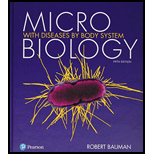
Pearson eText Bauman Microbiology with Diseases by Body Systems -- Instant Access (Pearson+)
5th Edition
ISBN: 9780135891018
Author: ROBERT BAUMAN
Publisher: PEARSON+
expand_more
expand_more
format_list_bulleted
Concept explainers
Question
Chapter 13, Problem 3TMW
Summary Introduction
To tell:
Why the lysogenic and latent phases are longer lasting than lytic infections.
Introduction:
In order to replicate and produce copies of its own, the viruses need a host cell to survive. All viruses enter the host through attachment, entry, synthesis, assembly, and release. Depending upon the state of the virus, they can carry out lytic cycle or lysogenic cycle.
Expert Solution & Answer
Trending nowThis is a popular solution!

Students have asked these similar questions
tell us about one time when you went the extra mile when it would be acceptable to perform the bare minimum. why did you exert the extra effort and what was the outcome?
list 4 basic laboratory practices
what does WHMIS stand for why is it important?
Chapter 13 Solutions
Pearson eText Bauman Microbiology with Diseases by Body Systems -- Instant Access (Pearson+)
Ch. 13 - Why are naked icosahedral viruses able to...Ch. 13 - What characteristics of the genomes of...Ch. 13 - Prob. 3TMWCh. 13 - Prob. 1EDCSCh. 13 - Prob. 4TMWCh. 13 - Prob. 5TMWCh. 13 - Prob. 6TMWCh. 13 - Prob. 7TMWCh. 13 - Prob. 1CCSCh. 13 - Prob. 1MC
Ch. 13 - Prob. 2MCCh. 13 - Prob. 3MCCh. 13 - Prob. 4MCCh. 13 - Prob. 5MCCh. 13 - Prob. 6MCCh. 13 - Prob. 7MCCh. 13 - Prob. 8MCCh. 13 - Prob. 9MCCh. 13 - Prob. 10MCCh. 13 - Prob. 1MCh. 13 - Prob. 1VICh. 13 - Prob. 2VICh. 13 - Prob. 1SACh. 13 - Prob. 2SACh. 13 - Prob. 3SACh. 13 - Prob. 4SACh. 13 - Prob. 5SACh. 13 - What is the difference between a virion and a...Ch. 13 - How is a provirus like a prophage? How is it...Ch. 13 - Prob. 8SACh. 13 - Prob. 9SACh. 13 - Prob. 10SACh. 13 - Prob. 1CTCh. 13 - Prob. 2CTCh. 13 - Prob. 3CTCh. 13 - Prob. 4CTCh. 13 - Prob. 5CTCh. 13 - Prob. 6CTCh. 13 - Prob. 7CTCh. 13 - Why has it been difficult to develop a complete...Ch. 13 - Prob. 9CTCh. 13 - What differences would you expect in the...Ch. 13 - Prob. 11CTCh. 13 - Prob. 12CTCh. 13 - Prob. 13CTCh. 13 - Using the following terms, fill in the following...
Knowledge Booster
Learn more about
Need a deep-dive on the concept behind this application? Look no further. Learn more about this topic, biology and related others by exploring similar questions and additional content below.Similar questions
- when we collect fish or mussels we record a variety of biological information, including but not limited their sex, length, weight or a scale or finray or other tissue sample. Why do we do this, and what information are we hoping to obtain from these measurements and taking these samples?arrow_forwardDraw a rough sketch of the control and experimental data using a normal dose/response curve plot: i.e. % of total bound ligand vs. concentration. Indicate Kd and Bmax on this sketch. You don’t need to use exact numbers, but the relative proportions should be closearrow_forwardName something that could be happening to glutamate transporters that could have this effect on glutamate transport (i.e. the difference in glutamate transporters between control and experimental conditions). (Bonus: if you can also guess what the experimental condition is).arrow_forward
- a. For the control condition, calculate Kd. Include units and show your work. b. For the control condition, calculate Bmax. Include units and show your work. c. For the experimental condition, calculate Kd. Include units and show your work. For the experimental condition, calculate Bmax. Include units and show your work.arrow_forwardNow draw a rough sketch of what the control data might look like if in addition to the specific binding, there was also a considerable amount of nonspecific binding (again using a normal dose/response curve)arrow_forwarda. Which drug is the most potent? a,b,c,d,e b. Which drug has the highest efficacy?arrow_forward
- The shape of radishes may be long (SL/SL), oval (SL/SS), or round (SS/SS), and the color of radishes may be red (CR/CR), purple (CR/CW) or white (CW/CW). If a long, red radish plant is crossed with a round, white plant, what will be the appearance of the F1 and F2 generations?arrow_forwardNonearrow_forwardQuestion #3: In the KeyGene paper, the authors state that it would be useful if pollen from an apomict would transmit apomixis-inducing genes to the female in the cross (assuming the pollen is viable). Assuming there was just one gene conferring gametophytic obligate apomixis, and that the two parents are inbreds, what would be the consequences of such a cross if: a) The apomixis was a dominant trait? Indicate the genotypes and phenotypes (apomict or non- apomict) of the parents, F1 and F2 generations. Remember to include the expected genotypic and phenotypic ratios (or percentages) in the F1 and F2 generations, and to position the female first (left side) in the parental cross. b) The apomixis was a recessive trait? Indicate the genotypes and phenotypes (apomict or non- apomict) of the parents, F1 and F2 generations. Remember to include the expected genotypic and phenotypic ratios (or percentages) in the F1 and F2 generations, and to position the female first (left side) in the…arrow_forward
arrow_back_ios
SEE MORE QUESTIONS
arrow_forward_ios
Recommended textbooks for you
 Human Heredity: Principles and Issues (MindTap Co...BiologyISBN:9781305251052Author:Michael CummingsPublisher:Cengage Learning
Human Heredity: Principles and Issues (MindTap Co...BiologyISBN:9781305251052Author:Michael CummingsPublisher:Cengage Learning- Surgical Tech For Surgical Tech Pos CareHealth & NutritionISBN:9781337648868Author:AssociationPublisher:Cengage



Human Heredity: Principles and Issues (MindTap Co...
Biology
ISBN:9781305251052
Author:Michael Cummings
Publisher:Cengage Learning



Surgical Tech For Surgical Tech Pos Care
Health & Nutrition
ISBN:9781337648868
Author:Association
Publisher:Cengage